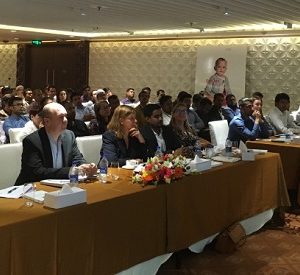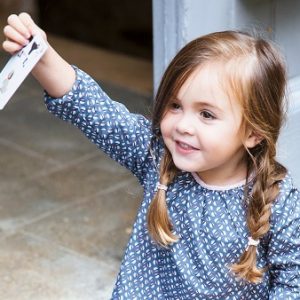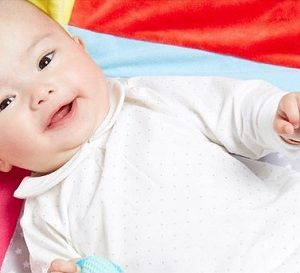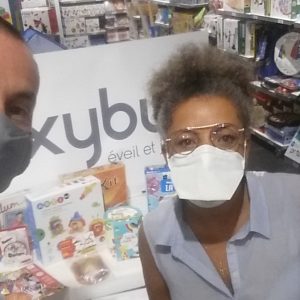

In 2012 the first Rigolo Comme La Vie crèche opened in Roubaix based on an educational model that seeks to foster environmental awareness, among other things. What does that mean in practice?
To explain is Charlotte, principal of the Roubaix crèche and its 40 children. Belinda, mum to Basile, nearly two, also gives her thoughts.
Charlotte, where did the idea for an environmentally aware crèche come from?
We opened the crèche at the request of Sésame, a local charity, and Ankama, an entertainment and gaming firm based in Roubaix that pays for a portion of the places. Ankama had just moved to the district, which happens to straddle a wildlife corridor[1]. So it was only natural that we decided to put environmental awareness at the heart of the school.
How does it work in practice?
The first step was to design the crèche buildings and layout in line with our concern for the environment. The premises were deliberately set up near public transport facilities and fitted with bicycle sheds to cater to parents opting for sustainable modes of transport.
Converted from an old factory with a wooden extension, the crèche building is quite open to the outside and bathed in natural light. It is heated by a wood-fired boiler. We also have a pretty garden with a small vegetable patch, a composter and a rainwater harvesting system. Gardening and nature watching are intrinsic to our activity programme and we have partnerships with groups that look after the surrounding nature.
What do you do on a daily basis?
In addition to and in line with Roubaix’s pioneering zero waste initiative, the crèche pays special attention to sorting. We use all kinds of junk like nappy boxes, toilet roll tubes, caps and plastic bottles to make things during all our creative activities, and parents are asked to set aside any useful items when they sort their own rubbish. Once we even organized a sharing workshop on sewing to teach parents how to make activity mats.
The children love to take part. The tunnel they recently made out of boxes with an intern has been their favourite game for weeks. They were so proud to show how they had decorated it with sticky labels!
We took it one step further with a swap scheme encouraging parents to give away anything their children were no longer using – like clothes, shoes and babycare items – that others might find useful, rather than throw it away. It makes for great exchanges.
Do you also buy responsibly?
For both environmental and economic reasons, we make many of our consumables like paint, modelling clay and glue ourselves.Whenever we have to buy new toys, we do our best to source ones made from recycled materials.
Disposable consumables are kept to a minimum. For instance, we replaced cotton wool with facecloths sewn by parents, disposable booties with washable ones, and plastic packets with handwoven bags made by one of our mums.
The children’s meals are made by Croc’la vie, a caterer that only uses organic and local produce. Mashed potatoes and fresh vegetables are regulars and always taste so good. They’re getting it right, because at the end of the year parents tell us how their kids aren’t picky eaters any more. They’re delighted!
Have the parents come on board?
Some enrol their children with us out of principle. They’re very involved and have high expectations. Some parents help us with the garden, others lend a hand with sewing.
Others come along for the ride, so to speak, and pick up a few ideas or habits here and there that they apply back home.
What about the kids?
For the bigger ones it’s a case of watch and learn. As they observe, hear and copy what we do and play sorting games with us, certain things start to become second nature. We’re preparing the ground for later.
What’s next?
Now that it’s allowed, I’ve challenged our staff to shift to homemade cleaning products. We’ve teamed up with Astuce, a local association, to create a sensory garden filled with household junk and natural objects to stimulate the senses at an early age. We’ll begin setting it up next month.
On a broader note, without getting bogged down in buzzwords, I’d like us to move towards becoming an ecocrèche. It’s a team effort. Watch this space!

Here’s Belinda, mum to Basile, nearly two
It so happened that the Rigolo Comme La Vie-Sésame crèche was the daycare centre for the company my husband works at. Knowing it provided organic children’s meals and took waste management seriously played a big part in our decision.
I was really chuffed when it switched from cotton wool to reusable flannels. It was a continuation of what I was already doing at home (we take a zero waste approach).
The staff also make a lot of their own stuff. That’s so great! I’ve picked up a few tips, and now my son and I recycle and reuse a lot.
One of the staff is in charge of taking out books from the library, I think it’s great not to buy as a matter of course.
The parents really like the swap cupboard. I’ve already given away some clothes.
Themed weeks are a regular occurrence. For instance, this week we can drop off used linen in LOVE BAGS to be recycled.
Everything is recorded in the children’s crèche diary. That’s where I got the homemade paint recipe from. We use it at home now!
Basile’s only two and already he’s picked
up some good habits, like throwing his tissue in the bin and putting his bib in
the washtub after afternoon snack. Baby steps!
[1]A strip of natural habitat in an urban area reconnecting fragmented spaces and helping ensure biodiversity so that animal species can move between regions and complete their life cycles.







